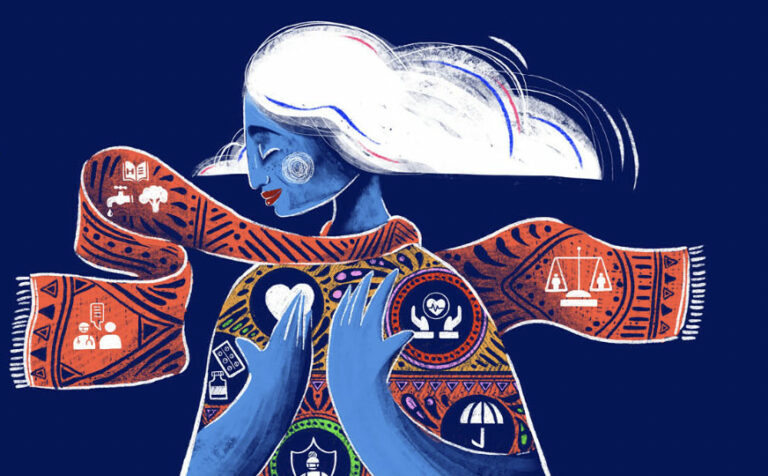
Women’s participation in the EU’s digital economy — bridging the gap
For Europe, a gender-inclusive recovery is vital for both society and the economy. The European Institute for Gender Equality has shown that Europe would benefit macroeconomically from a successful, all-encompassing gender equality strategy. In this situation, digital transformation is crucial. According to the report of the European Commission, “ICT for work: Digital skills in the workplace”, 90% of occupations now require basic digital skills.
On the occasion of International Women’s Day, I would like to highlight the importance of women’s participation in the digital world, specify the steps taken by the EU to facilitate the process of digital transformation for women, and analyse essential new EU legislation in this area.
While it is becoming more and more important for both men and women to fully participate in social and professional life, there are still considerable gaps between the types and degrees of digital skills that men and women acquire. The potential of research and development activities is constrained by the shockingly high gender inequality among researchers who create, design, and develop digital services and products.
The Digital Economy and Society Index (DESI), which gathers a number of pertinent data on Europe’s digital policies, serves as a gauge for the EU’s success in the digital sphere. The association between the Digital Economy and Society Index and the Gender Equality Index demonstrates that societies with greater gender equality also perform better in the digital economy, which is essential for long-term economic success.
The states which perform better according to both Digital Economy and Society Index and Gender Equality Index are Denmark, Sweden, the Netherlands and Finland. Numbers prove that it is possible to address the digital gender gap by progressing in resolving divides in gender equality generally.
Statistically speaking, gaps between male and female representation exist in plenty of digital directions:
- Access to connectivity and digital technologies
According to the European Institute for Gender Equality (EIGE) report, daily internet use is almost equal for both sexes – 76% of women and 78% of men. However, as reported by the Organisation for Economic Co-operation and Development, even those women who have daily Internet access use it for less difficult queries than men. The situation worsens when we look at age and educational background. For example, among people with poor education, 21% of men have never used the internet, rising to 27% of women.
- Development activities held online
There are slight gender disparities in online learning, where women are more present in searching for training courses and educational activities leading to professional development. The percentage of women who regularly use the internet for such activities varies from 95% in Sweden to 66% in Bulgaria. Additionally, according to the EIGE study on youth and digitalization, women between the ages of 16 and 24 are more inclined to use technology in a creative way for online sharing than men of the same age, 60% and 56% respectively.
- Use of mobile connection and representation in social media for professional purposes
When it comes to professional digital activities, a large gender gap remains. For example, nearly half as many women with a good educational background (19%) are using mobile internet for professional purposes as men (33%). There is also a large gap in women’s representation in professional social networks, such as LinkedIn. According to statistical data, female representation is 43.7% compared to 56.3% of males.
- ICT representation
According to 2018 Eurostat data, just 1% of girls said they intended to work in an ICT-related sphere (compared to 10% of boys). Moreover, in accordance with STEM education statistics in 2023 less than 30% of researchers are women, which is an underrepresentation of women in STEM fields both globally and in Europe. ICT is characterised by a significant degree of gender segregation, with 82% of students being male. Numbers are supported by the DESI 2022 report stating that one in three STEM graduates and just 19% of ICT specialists are female. Consequently, in the EU, men make up more than 8 out of 10 IT specialists on average.
- Entrepreneurship and start-up representation
According to EIGE calculations based on EU-LFS microdata, women are marginalised to an even higher extent in tech start-ups, with just 7% of independent IT professionals employing at least one female employee. According to the EU Start-up Monitor 2020-2021, all-women teams represent only 7% of start-ups, compared to 64% for all-male teams. According to OECD research, start-up companies run by women typically obtain approximately 20% less investment than those by males.
- Research and development sector
According to the EIGE report, very few female scientists and engineers work in high-tech fields that are likely to be involved in the creation of new digital technologies. Just one fifth of the over 32 million scientists and engineers working in high-tech fields in the EU in 2019 were female. Since 2010, that share has not changed.
Observing those numbers, it becomes clear that women’s engagement in the digital transformation is poor, disadvantaged and vague. Since the outbreak of Covid-19, society consciously made a shift towards long-term, sustainable digital transition. The NextGenerationEU plan was the first pillar towards a system of full Covid recovery, which, amongst many things, marked the beginning of Europe’s digital decade aimed at modernisation and safe digital usage by 2030 through skills, digital transformation of business, secure and sustainable digital transformations and digitalisation of public services.
So, what’s in it for women?
In 2018, the European Commission launched the Women in Digital strategy, the goal of which is to encourage and inspire women to take on more leadership roles in the digital era. A sustainable, just, and equitable economy and society require the active engagement of women. The three areas of attention are as follows:
- Promoting digital skills and education
In 2019, Commissioner Mariya Gabriel launched the European Network for Women in Digital – a mechanism to encourage coordination of current projects by bringing together organisations that may exchange ideas and experiences to generate a stronger effect on developing a digital sector that is targeted towards women. Additionally, plenty of workshops on coding and digital traineeships are taking place to upgrade the digital skills of girls and women.
- Challenging digital stereotypes
Creation of the “No women no panel” campaign with the aim of increasing awareness of the need for having a gender balance on panels and other public events. Commissioner Mariya Gabriel pledged to make sure that there would be at least one woman panellist for each discussion or public event to which she was invited.
The European Digital Skills Awards has a special “Women in ICT Careers” category, which is designed to boost the proportion of female ICT professionals, as well as to upskill working women and younger women in digital technologies.
- Advocating for more women entrepreneurs
The EU Award for Women Innovators honours the female entrepreneurs who are responsible for ground-breaking inventions. The EU hopes to accomplish this through increasing awareness of the need for more female innovators and by establishing role models for girls and women all across the world.
Another recent project of the European Union is called Women TechEU. This programme provides female founders with top-notch coaching and mentoring, as well as targeted funding to advance their businesses.
The EU has also supported the CEO Declaration on closing the digital gender gap in high-tech companies, which is a tangible step toward creating a diverse, open, and inclusive corporate ecosystem that assumes gender equality that goes beyond stereotypes.
Within the framework of the EU’s Women in Digital strategy, the European Commission collaborates with the EU’s member states, which have signed the EU Women in Digital Declaration. To advance gender equality in technology, EU member states will collaborate closely with the public and business sectors as well as with civil society. The Women in Digital Scoreboard, a component of DESI, has been introduced to track progress. Based on thirteen factors, the scoreboard evaluates Member States’ performance in the areas of internet use, digital skills, specialised skills, and employment.
An updated EU policy initiative called the Digital Education Action Plan (2021–2027) lays out a shared vision for high-quality, inclusive, and accessible digital education across Europe and intends to support member states’ efforts to modernise their educational and training systems. One action focuses on women’s participation in STEM, with key activities including:
- Creation of online platform Girls Go Circular – to provide girls with training in sustainable and digital business skills during their secondary school.
- Organisation of E-STEAM festivals – to develop girls’ and women’s self-confidence to use digital skills creatively, identify opportunities, invent, and contribute to society.
- Elaboration of the EU STEM Coalition – to help in the creation of a national STEM platform.
To support women’s transition to the digital era, on 21 January 2021, the European Parliament adopted a resolution on Closing the digital gender gap: women’s participation in the digital economy. Further, in its Communication on the Digital Compass: The European Way for the Digital Decade, released on 9 March, 2021, the Commission outlined its goal for Europe’s digital transformation by the year 2030, making it clear that more women should apply for the 20 million ICT expert jobs that are expected to be available in the EU.
As for EU external action, to advance gender equality and women’s empowerment via all of the European Union’s external activities, the EU put out an ambitious Gender Action Plan III: towards a gender-equal world. This is policy framework with five pillars of action, which will help move more quickly toward fulfilling its international obligations and creating a world where everyone can prosper. It prioritises the advancement of gender equality in all external policies and initiatives, provides a road map for cooperating with stakeholders at the national, regional, and multilateral levels, intensifies action in key strategic thematic areas, exhorts institutions to set a positive example, and ensures the results are transparent. The 3rd pillar especially corresponds to empowering women worldwide in terms of digital transition.
Consequently, successful integration into the digitised economy and more complex types of IT work requires the use of digital technology for business reasons. Employees must adapt by undergoing continual training to advance their digital abilities, depending on their industry and particular jobs, given how quickly digital innovations are developing. Women are frequently discouraged from choosing ICT-related training due to negative gender stereotypes. The ongoing gender segregation in STEM is influenced by a variety of factors such as the absence of work-life balance choices and role models, gender stereotypes and the gender gap in educational attainment and digital abilities. Though it is a matter of years of dedicated and hard work, I believe that the EU Women’s in Digital initiative will bring great results for both European and international society.
LATEST

Four Ukrainian women: stories of courage and greatness

The Lost Generation

How you can help the planet every day

Building Europe: Poland’s experience of joining the European Union and lessons for Ukraine

World Health Day 2024: My Health, My Right
More campaign pages:
Interested in the latest news and opportunities?
This website is managed by the EU-funded Regional Communication Programme for the Eastern Neighbourhood ('EU NEIGHBOURS east’), which complements and supports the communication of the Delegations of the European Union in the Eastern partner countries, and works under the guidance of the European Commission’s Directorate-General for Neighbourhood Policy and Enlargement Negotiations, and the European External Action Service. EU NEIGHBOURS east is implemented by a GOPA PACE-led consortium. It is part of the larger Neighbourhood Communication Programme (2020-2024) for the EU's Eastern and Southern Neighbourhood, which also includes 'EU NEIGHBOURS south’ project that runs the EU Neighbours portal.

The information on this site is subject to a Disclaimer and Protection of personal data. © European Union,